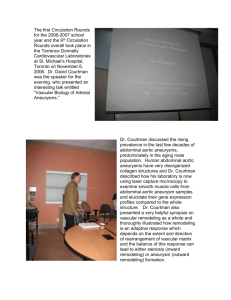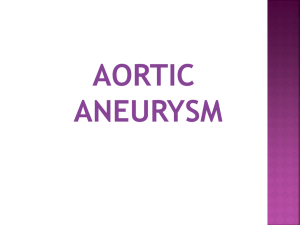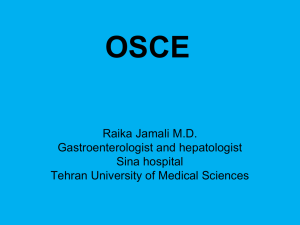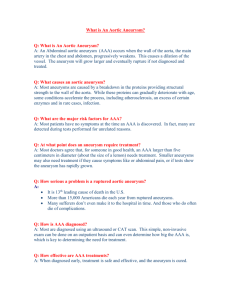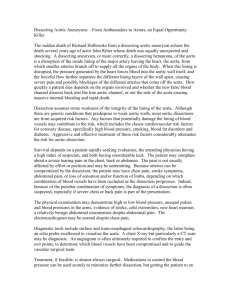CONGESTIVE HEART FAILURE
advertisement
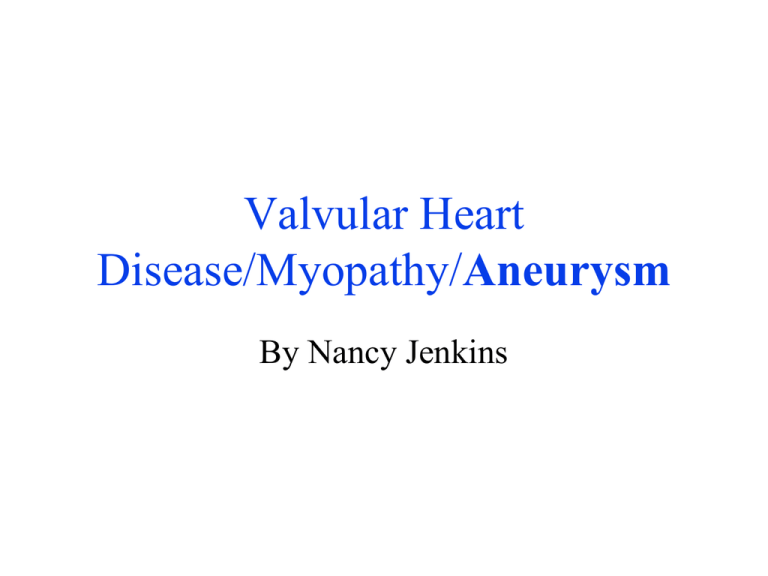
Valvular Heart Disease/Myopathy/Aneurysm By Nancy Jenkins Definition • Abnormal dilation of a blood vessel at a site of weakness or a tear in the vessel wall. • Usually secondary to atherosclerosis. • Most commonly affect the aorta Bing Video: Abdominal Aortic Aneurysm Surgery Aortic Aneurysms • Atherosclerotic plaques deposit beneath the intima – Plaque formation is thought to cause degenerative changes in the media – Leading to loss of elasticity, weakening, and aortic dilation • Dilated aortic wall can become lined with thrombi than can embolize – Leads to acute ischemic symptoms in distal branches – Important to assess peripheral pulses Aorta • Largest artery • Responsible for supplying oxygenated blood to essentially all vital organs • **Aneurysm can occur in any artery but the aorta is most common • Growth rate unpredictable – **Larger the aneurysm greater risk of rupture May also involve the aortic arch or the thoracic aorta, Most (3/4) are found in abdominal aorta below renal arteries ¼ are found in the thoracic area Aortic Aneurysms – Studies suggest strong genetic predisposition • *Male gender and smoking stronger risk factors than hypertension and diabetes • Abdominal aortic aneurysms (AAA) – Occur in 4.1% to 14.2% of men – 0.35% to 6.2% of women over 60 – Cause of 16,000 deaths per year Risk Factors- Atherosclerosis Fusiform Most AAA are fusiform and 98% are below the renal artery Aortic Aneurysms Classification • False aneurysm – Also called pseudoaneurysm – Not an aneurysm – Disruption of all layers of arterial wall • Results in bleeding contained by surrounding structures • Pseudoaneurysm: an outpouching of a blood vessel, involving a defect in the two innermost layers (the tunica intima and media) with continuity of the outermost layer, the adventitia. Alternatively, all three layers are damaged and bleeding outside of the vessel is contained by a clot or by surrounding tissue. False Aneurysms • May result from – Trauma – Infection – After peripheral artery bypass graft surgery at site of anastomosis – Arterial leakage after cannulae removal Aortic Aneurysm Diagnostic Studies • X-rays- Most are diagnosed without symptoms on routine X-ray – Chest - Demonstrate mediastinal silhouette and any abnormal widening of thoracic aorta – Abdomen -May show calcification within wall of AAA • ECG -to rule out MI Aortic Aneurysm Diagnostic Studies • Echocardiography – Assists in diagnosis of aortic valve insufficiency • Related to ascending aortic dilation • Ultrasonography – Useful in screening for aneurysms – Monitor aneurysm size Aortic Aneurysm Diagnostic Studies • CT scan – Most accurate test to determine • Anterior to posterior length • Cross-sectional diameter • Presence of thrombus in aneurysm • MRI – Diagnose and assess the location and severity Aortic Aneurysm Diagnostic Studies • Angiography – Anatomic mapping of aortic system using contrast – Not reliable method of determining diameter or length – Can provide accurate info about involvement of intestinal, renal or distal vessels Clinical Manifestations By LocationThoracic Aortic Aneurysm • Frequently asymptomatic • May have substernal, neck or back pain • Coughing, due to pressure placed on the windpipe (trachea) • Hoarseness • Difficulty swallowing • Swelling (edema) in the neck or arms • Myocardial infarction, or stroke due to dissection or rupture involving the branches of the aorta Ascending Aortic Aneurysm Aortic Arch Clinical Manifestations ASH – Angina – Hoarseness – If presses on superior vena cava • Decreased venous return can cause – Distended neck veins – Edema of head and arms Abdominal Aortic Aneurysm Clinical Manifestations • Abdominal aortic aneurysms (AAA) – Often asymptomatic – Frequently detected • On physical exam – Pulsatile mass in periumbilical area (Grey’s Anatomy) – Bruit may be auscultated • When patient examined for unrelated problem (i.e., CT scan, abdominal x-ray) Aortic Aneurysm Clinical Manifestations • AAA, con’t – May mimic pain associated with abdominal or back disorders – Pain correlates to the size- can be excrutiating – May spontaneously embolize plaque • Causing “blue toe syndrome” patchy mottling of feet/toes with presence of palpable pedal pulses • It can rupture, causing shock and death in 50% of rupture cases – Nursing Diagnoses • • • • • Risk for Ineffective Tissue Perfusion Risk for Injury Anxiety Pain Knowledge Deficit Medical Treatment of Aneurysms- if less than 5cm • Anti-hypertensives – – – – Beta blockers, Vasodilators Calcium channel blockers Nipride • Sedatives • Niacin, mevocor, statins Post-op anti-coagulants Complication Aortic Dissection • Blood invades or dissects the layers of the vessel wall- most often thoracic Aortic dissection - Wikipedia, the free encyclopedia Dissecting aneurysms are unique and life threatening. A break or tear in the tunica intima and media allows blood to invade or dissect the layers of the vessel wall. The blood is usually contained by the adventitia, forming a saccular or longitudinal aneurysm. Aortic Dissection • Affects men more often than women • Occurs most frequently between fourth and seventh decades of life • Acute and life threatening • Mortality rate 90% if not medically or surgically treated Aortic Dissection Etiology and Pathophysiology • As heart contracts, each systolic pulsation ↑ pressure on damaged area – Further ↑ dissection – May occlude major branches of aorta • Cutting off blood supply to brain, abdominal organs, kidneys, spinal cord, and extremities • People with Marfan’s at risk Manifes tations of Aortic D is s ection Aneurys m Abrupt, s evere, ripping or tearing pain in area of aneurys m Mild or marked hypertens ion early Weak or abs ent puls es and blood pres s ure in upper extremities S yncope C omplications : hemorrhage, is chemic kidneys (renal failure), MI, heart failure, cardiac tamponade, s eps is , weaknes s or paralys is of lower extremities . Aortic Dissection Collaborative Care • Initial goal – ↓ BP and myocardial contractility to diminish pulsatile forces within aorta • Drug therapy – IV β-adrenergic blocker • Esmolol (Brevibloc) – Other hypertensive agents • Calcium channel blockers • Sodium Nitroprusside • Angiotensin-converting enzyme Aortic Dissection • Surgical therapy – When drug therapy is ineffective or – When complications of aortic dissection are present • Heart failure, leaking dissection, occlusion of an artery – Surgery may be delayed to allow edema to decrease and permit clotting of blood. – Even with prompt surgical intervention • 30-day mortality of acute aortic dissections remains high (10%-28%) AAA-Medical Treatment - Surgery or Stent • Usually repaired if >5cm • Open procedure- abd incision, cross clamp aorta,aneuysm opened and plaque removed, then graft sutured in place. Care much like after CABG (Not done as much anymore unless a rupture) – Pre-op assess all peripheral pulses – Post-op-check urine output and peripheral pulses hourly for 24 hours- (when to call Dr.) • Endovascular stents- placed through femoral artery Stent Graft Repair http://www.y Aortic Aneurysm • Endovascular graft procedure, con’t – Approach is percutaneous femoral access • Advantages – – – – Shorter operative time Shorter anesthesia time Reduction in use of general anesthesia Reduced groin complications within first 6 months Open Repair of AAA • Post-Op- Similar to CABG • ICU monitoring – Arterial line – Central venous pressure (CVP) or pulmonary artery (PA) catheter – Mechanical ventilation – Urinary catheter – Nasogastric tube – ECG – Pulse oximetry – Pain medication Nursing Management Nursing Implementation • Acute Intervention – Postop, continued • Cardiovascular status – – – – – Continuous ECG monitoring Electrolyte monitoring Arterial blood gas monitoring Oxygen administration Antidysrhythmic/pain medications Nursing Management Nursing Implementation • Acute Intervention – Postop, continued • Infection – – – – – Antibiotic administration Assessment of body temperature Monitoring of WBC Adequate nutrition Observe surgical incision for signs of infection Nursing Management Nursing Implementation • Acute Intervention – Postop, continued • Gastrointestinal status – – – – Nasogastric tube Abdominal assessment Passing of flatus is key sign of returning bowel function Watch for manifestations of bowel ischemia Nursing Management Nursing Implementation • Acute Intervention – Postop, continued • Neurologic status – – – – – – Level of consciousness Pupil size and response to light Facial symmetry Speech Ability to move upper extremities Quality of hand grasps Nursing Management Nursing Implementation • Acute Intervention – Postop, continued • Peripheral perfusion status – Pulse assessment • Mark pulse locations with felt-tip pen – Extremity assessment • (5P’s) Temperature, color, capillary refill time, sensation and movement of extremities Nursing Management Nursing Implementation • Acute Intervention – Postop, continued • Renal perfusion status – – – – – Urinary output Fluid intake Daily weight CVP/PA pressure Blood urea nitrogen/Creatinine Nursing Management • Ambulatory and Home Care • • • • Encourage patient to express concerns Patient instructed to gradually increase activities No heavy lifting Educate on signs and symptoms of complications • Infection • Neurovascular changes Prevention • 1.Ultrasound is extremely effective at detecting AAAs.The U.S. Preventive Services Task Force (USPSTF) recommends that anyone aged 65 to 75 who has ever smoked undergo a onetime ultrasound screening for AAA • 2.Prevent atherosclerosis • 3.Treat and control hypertension • 4.Diet- low cholesterol, low sodium and no stimulants • 5.Careful follow-up if less than 5cm. It can grow .5cm /year Other Complications • Rupture- signs of ecchymosis (triad) – Back pain – Hypotension – Pulsating mass • Thrombi • Renal Failure Rupture Triad Back pain Hypotension Pulsating hematoma Rupture • Rupture- serious complication related to untreated aneurysm – Posterior rupture • Bleeding may be tamponaded by surrounding structures, thus preventing exsanguination and death • Severe pain • May/may not have back/flank ecchymosis Anterior rupture • Massive hemorrhage • Most do not survive long enough to get to the hospital WHY?? Rupture False Aortic Aneurysm with Rupture of the Aorta : Medical Animation http://www.austincc.edu/adnlev4/rnsg2331online/m odule05/aneurysm_case_study.htm Student Case Study Patient History 27 year old male African American L ives alone in apartment F amily hx D M Morbid obesity (314.6 lbs ) Height: 5’11 Ambulates with walker F ull C ode Medical His tory: E T O H abuse S moker Hypertens ion DOE S leep apnea T rach (8/30) E jection F raction 50% Hemodialys is (M-W-F ) Mitral insufficiency, Mild regurgitation(mitrial, tricuspid) P ress ure ulcer on coccyx R espiratory failure with trach , pneumonia, delirium (8/13) P t appeared in E R w c/o flank and abd pain B /P 270/159 (C ardene drip which decreas ed pres sure to 185/73) Na 138 K 4.4 C h108 B UN 24 C reat 3.0 G lucos e 147 C a 8.5 H gb 12.5 Admis s ion diagnos is : Malignant hypertens ion T ype B Aortic D is s ection R enal ins ufficiency Morbid obes ity P t teaching: S moking ces s ation C ontrol H TN L ifes tyle changes D iet control Us e of s tool s ofteners (increase fluid and fiber in diet) • E X T R A D X D E VE L O P E D D UR ING HO S P IT AL S T AY : • Myopathy • Acute res piratory failure • C hronic kidney dis eas e • P neumonia due to S taph and Hemophilus Influenze • HT N encephalopathy acute renal dis eas e with les ion of tubular necros is • D elirium • Uns pec d/o of kidney and ureter S urgery • S urgery is done when an aneurys m is 6 cm in diameter, expanding fas t or s ymptomatic. T ype B dis s ections are s urgically repaired depending on extent of involvement and ris k for rupture. • Aneurys m excis ed and replaced with s ynthetic fabric graft. Ns g D x: • R is k for Ineffective tis s ue perfus ion. • Anxiety Medications Allergy:PCN T reated with long term beta blocker therapy and antihypertens ive drugs as needed to control heart rate and blood pres s ure. Initially treated with I.V beta blockers s uch as propranolol (Inderal), metoprolol (L opres s or), Normodyne or B revibloc to reduce heart rate to 60 bpm. Nipride infus ion to reduce s ys tolic to 120mmHg. C alcium channel blockers may als o be us ed. D irect vas odilators are avoided becaus e they may wors en the dis s ection. After s urgery anticoagulants may be initiated; us ed indefinitely and maybe even lifelong. P t meds : Albuterol 2.5mg IH q8h H eparin 5000u S Q q8h F lonas e nas al s pray 2 s prays each nos e q12h Amphojel 1020mg q8h C atapres s 0.2mg q4h Minoxidil 10mg P O q12h E ns ure s upp 240ml P O T ID P rotonix 40mg po d Multivitamin 1 tab P O d L exapro 20mg P O d R enal D iet P rocrit 10000u S Q MWF R P ermacath, R AC , S L

